
|
Vol 70 |
Page 15 |
Privacy Policy | Editorial Policy | Profit Policy | Join the Association | List of Members | Contact us | Index | Links
Back Go to page: 1 2 3 4 5 6 7 8 9 10 11 12 13 14 15 16 17 18 19 20 Forward
Contents
A history of TAA Bristol Freighters in New Guinea.?
A History of TAA Bristol Freighters flown in New Guinea.
Ron Austin
Bristol Captain
1963-1966
This is a story of how it came to be that TAA pilots in New Guinea were flying 2nd hand freighter aircraft purchased from Pakistan.
Some background.
The introduction of Bristol Freighters into Pakistan was a political decision of the British Government. In 1948 the Pakistan Air Force had ordered a batch of Bristol Brigand fighters from England and then cancelled the order. The British demanded compensation and substituted the order with Bristol Freighters. These strange aircraft were unwanted but the contract was completed. A total of 71 Freighters, Mark 21s and 31s were ferried from England to the Pakistan Air Force and these aircraft apparently did provide satisfactory service for their Air Force.
The majority were used
for general Air Force operational flying but many were converted for
special projects. Some were modified for VIP travel, five of them were
fitted with spray equipment to spray plagues of locusts and several
aircraft were modified in 1953 to carry a 4000 lb. bomb. These
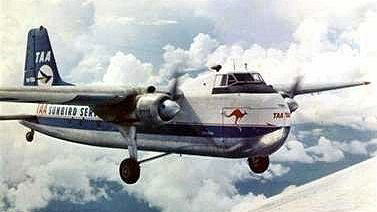 special
“bomber” aircraft had been fitted with under wing hard points to carry
the bombs and had a clear plastic panel built into the bottom of the
large front clam shell doors. One can assume, to be used with a bomb
sight.
special
“bomber” aircraft had been fitted with under wing hard points to carry
the bombs and had a clear plastic panel built into the bottom of the
large front clam shell doors. One can assume, to be used with a bomb
sight.
With this background, in 1961 Trans Australian Airline joins the story as part of the B170 history.
TAA Bristol VH-TBA
Early in 1959 the Australian Federal Government had made a decision to replace Qantas, which operated within New Guinea, with the domestic airline Trans-Australian Airlines; they were to be the “carrier” responsible for all passenger and freight flights. At that time the largest aircraft Qantas used in NG was the Douglas DC3s. TAA soon realised that an aircraft larger than a DC3 was needed to move the heavy cargo expected to be delivered to NG in the near future.
Ansett Airlines (operating as Mandated Airlines) were also flying in NG in opposition to Qantas. It was decided that TAA and Mandated Airlines, as potential competing freight carriers in NG, would make a joint purchase, from Pakistan, of surplus Bristol Freighter aircraft. Australian crews flew these to Australia in 1961. There were three aircraft for MAL and 4 for TAA. After arrival, selected aircraft were serviced by their respective Airlines and then flown to NG. The aircraft for TAA were registered in Australia as VH-TBA, VH-TBB, VH- TBC and VH-TBD. TAA planned to use the first two in NG and to retain C and D in Australia for replacement parts. It was discovered that these ex-Pakistan aircraft were not the first Bristol Freighters to fly in NG.
In 1963, having been posted to New Guinea for 3 years, my flying endorsement training in NG was conducted by experienced pilots who were due to return to Australia at the end of their 3 year posting. They taught us, not only to find our way around the un-mapped Highlands, but also how to survive this different aviation environment while flying in the extremely dangerous mix of mountains, rocks and cloud.
During this introductory period on DC3’s, as part of an overall endorsement, we were taught to land on the steep 8% slope at Wau.
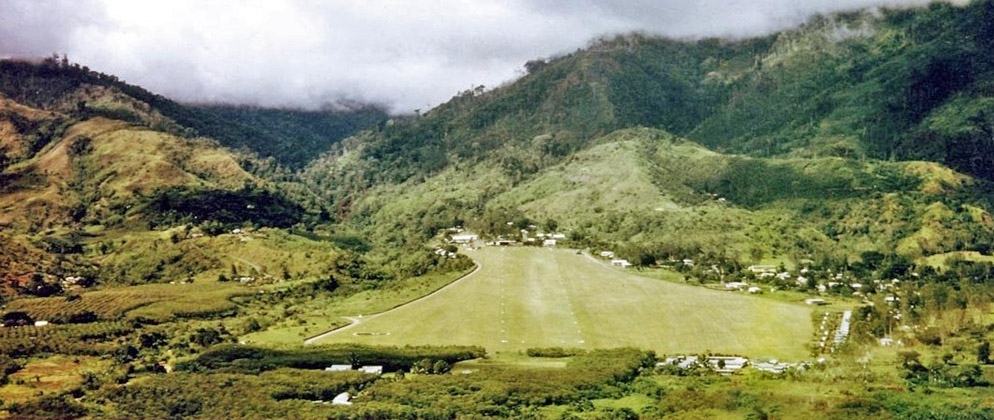
Wau airport (above) was built by gold mining pioneer Cecil Levien in 1927. The first landing was by “Pard” Mustar in a de Havilland 37 belonging to Guinea Gold Airways, Lae. Shortly thereafter many aircraft types, including the giant Junkers G-31 tri-motors were landing huge loads at Wau in support of the mining operation. At 3,475 feet above sea level and with almost a 10% slope, it was an ideal New Guinea airfield. During January 1942, Japanese forces from Salamaua and via the Black Cat Gap attacked Wau and were defeated by the Australian Kanga Force. The Japs got to the bottom boundary of the drome and Australian soldiers, landing in DC-3s with artillery, pushed them back.
With the Bristol we learned to increase the engine power immediately on touchdown to maintain our rolling inertia up the slope to the top of the grass field. We then swung the tail around until the aircraft was facing across the slope. The locals native Bois would then duck in under the engines with the wheel chocks, fit them tightly against the front and back of the wheels and only then, securely held, could we stop the engines. During discussion about the very steep slope on the field my instructor told a story of the Bristol Freighter which ran uncontrolled down the hill to crash at the bottom of the airport. He said “now it is used by the natives as a Boi house”
Recent research has
uncovered the true story of this first Bristol in NG and its early
demise. A demonstrator MK-1A, with registration G-AIMC, was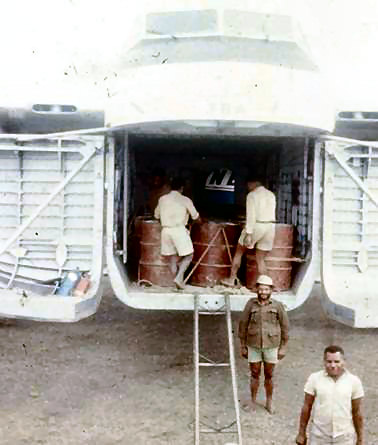 prepared by Bristol in England to undertake a sales tour of Australia
and New Guinea. It departed England in March 1947, arriving in Darwin
after 19 sector stops on the journey. On take-off from Darwin for
Melbourne, the upper access hatch behind the pilots broke off. I can
relate to this as I also lost a hatch, having failed to check that it
was locked after our radio had been serviced in Madang. In my case there
was no damage but in the Darwin incident the “flying” hatch detached and
damaged the tailplane. The demonstrator aircraft was repaired, and
although this delayed the New Zealand tour, it commenced on July 1947.
Back to Australia in October, the demo aircraft was serviced and then
loaned to QANTAS New Guinea for evaluation. Qantas flew it up to New
Guinea for trials.
prepared by Bristol in England to undertake a sales tour of Australia
and New Guinea. It departed England in March 1947, arriving in Darwin
after 19 sector stops on the journey. On take-off from Darwin for
Melbourne, the upper access hatch behind the pilots broke off. I can
relate to this as I also lost a hatch, having failed to check that it
was locked after our radio had been serviced in Madang. In my case there
was no damage but in the Darwin incident the “flying” hatch detached and
damaged the tailplane. The demonstrator aircraft was repaired, and
although this delayed the New Zealand tour, it commenced on July 1947.
Back to Australia in October, the demo aircraft was serviced and then
loaned to QANTAS New Guinea for evaluation. Qantas flew it up to New
Guinea for trials.
Loading aviation fuel drums.
Part of the overall assessment was operating in the highland goldfields of NG. It made several flights into grass strips at Wau and Bulolo. On this day the aircraft landed up the slope and stopped at the top facing up the slope, not across the slope parking as used by other aircraft. After stopping, chocks were fitted under the wheels and then the parking brake was applied. However, in this case the nipple on the parking brake became detached from the brake lever and the aircraft ran backward down the hill with the personnel still on board. The engineer and one other jumped clear but the rest were carried down the hill and over a 20 foot drop at the bottom. No one was injured.
Apparently, the reason they did not park across the slope on this occasion was because previously the side parking method had been tried, but the effect of the slope distorted the aircraft fuselage and made it difficult to lock the front clam shell doors. On this occasion the nose up parking was tried as a remedy. On impact with the ridge, the fuselage broke in the region of the rear door and the aircraft was declared damaged beyond repair. All equipment, including the engines, was removed for re-use. The fuselage remained there on site and is used as quarters for native employees of an adjacent coffee plantation. The aircraft had only flown 250 hours and was valued at 50,000 pounds.
The two TAA operational aircraft commenced their flights in New Guinea, VH-TBB in June 1961 and VH-TBA in September 1961.
The Bristol’s large load capacity was required because the NG Administration intended constructing a road suitable for trucks, from Lae Township to Goroka and Mt Hagen located in the centre of the Whagi valley in the Highlands. This was a very major undertaking. For the project they needed trucks, bridge girders, bulldozers, tractors, graders and similar gear which could only reach the Highlands of NG in an aircraft as large as the Bristol.
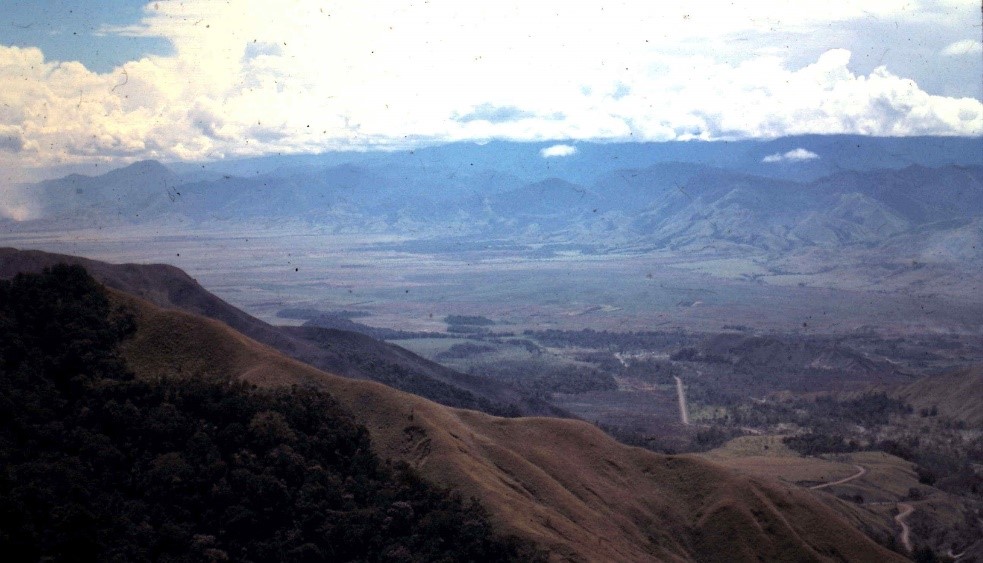
Other non-government contracts were also planned, one being to move the components of a complete new tea factory from the Madang wharf to the town of Mt Hagen, located in the Highlands at an elevation of 5500. We discovered the purchase order to the manufacturers in England for the tea factory included the specification that “every component must be designed to fit inside a Bristol Freighter”. When loading the ‘factory’ we found the large round condensers fitted into the aircraft hull almost like a cork in a bottle.
Other heavy freight items I have flown into the Highlands include complete D4 Caterpillar tractors; another was a road grader [stripped of its engine] but complete with the blade still attached to enable the unit to be unloaded with our portable ramps at destination. When carrying trucks as cargo, the wheels were often removed and they were rolled in on their brake drums. This reduced the height of truck to enable it to be moved far enough into the hull, below the wing structure, to be able to shut the door. Our cargo staff became quite versatile at finding solutions to loading difficulties!
In preparing the aircraft for NG operations, some upgrade modifications were completed in Australia by TAA to improve the overall safety of the proposed operations. A major change was to remove the Bristol brakes. Originally, they were fitted with typically English un-reliable air activated bag brakes and TAA replaced them with DC6 hydraulic brakes. To actuate these new brakes a converter was fitted which turned the original air pressure brakes into hydraulic pressure. The original air brakes had already dangerously failed during a training flight at Mangalore airport.
A hair-raising story of this brake bag failure was later described by Captain Ivan Neil.
When the aircraft first arrived in Melbourne, Ivan was one of two new Bristol Captains being converted to the type under the supervision of a senior TAA check pilot. During this conversion training at Mangalore, when the 2nd trainee was in the Captain’s seat doing circuits and landings, Ivan decided to watch a landing by lying down below on the floor of the cargo hold and looking through the Perspex panel fitted into the lower part of the door. After a smooth touch down, the brakes were applied and the pressure bag in one-wheel brake failed. Ivan hung on to the floor as well as he could while the aircraft turned left, ran off the edge of the runway then was steered, by rudder, back onto the hard stuff. Ivan said he would never go down there again.
When all necessary work was completed the aircraft were flown to Lae to commence the freight operation. TAA made a decision that the first flight in NG would be celebrated by an invitation to all local dignitaries. At the insistence of TAA management, Captain Neal departed for this flight in very marginal weather conditions. Immediately he departed the Tower declared “Lae airport is closed to all operations”. Shortly after, on climb out, one engine failed and had to be shut down. Capt. Neil advised by radio “returning to land at Lae”. The tower advised him the airport was closed and his reply was “Well, I am just about to reopen it.” This was typical of Ivan’s very positive approach as a Captain. All ended well.
Later the two Bristols were based in Madang as this town was the centre of the freight transfer into the interior of NG. The advantage of the airport at Madang was being adjacent to a cargo wharf and closest to the airstrips in the Highlands. The airport had a single runway used for all departures and arrivals and was sealed with bitumen. Most of the other landing strips used by us in the Highlands were either loose dirt or grass which was very slippery when wet. Many strips were one-way operations; you land uphill and then take off in the reverse direction, downhill.
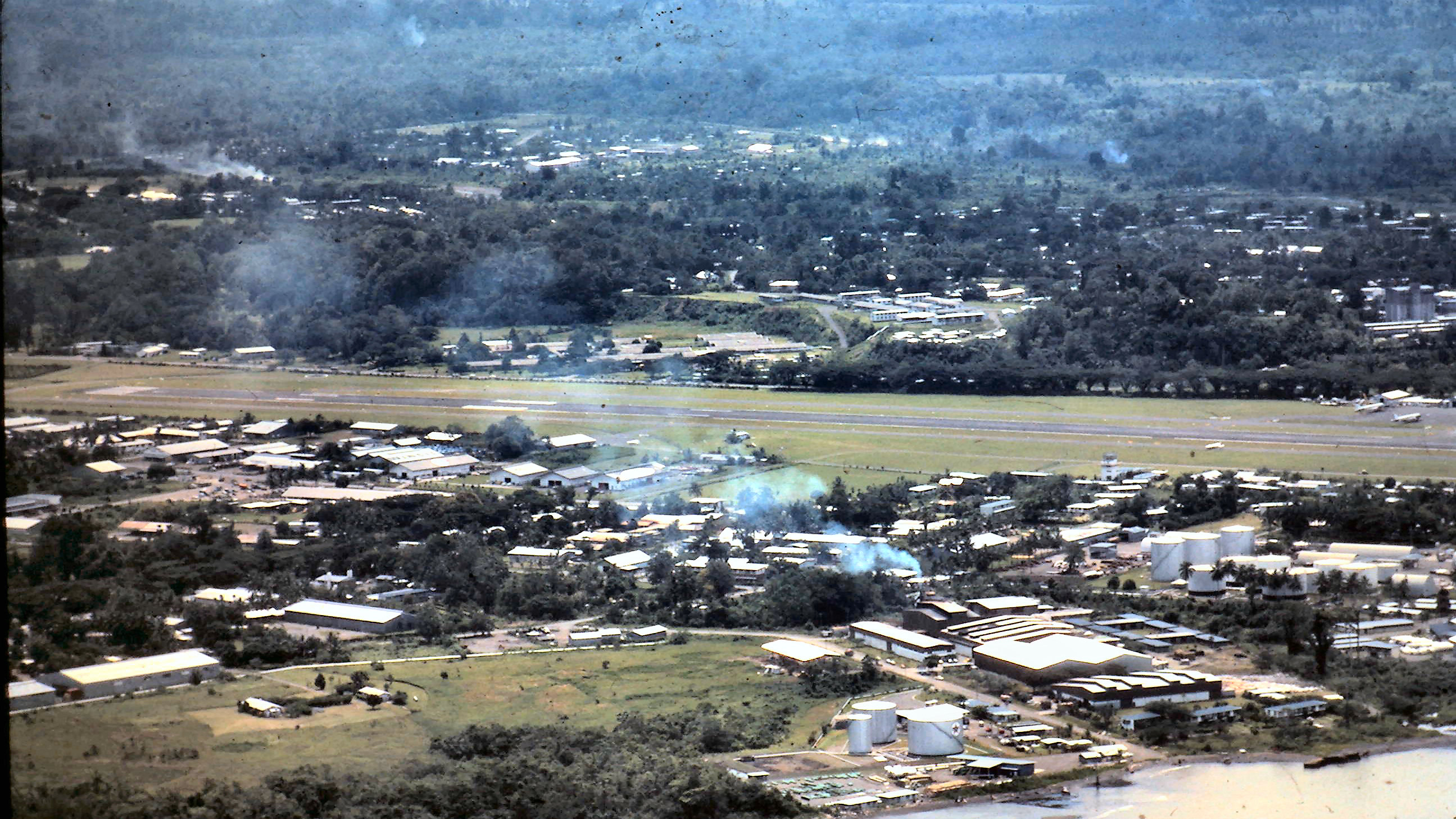
The TAA pilots required to fly the Bristol in NG usually completed a ground theory course in Australia before their posting. The in-flight training for the endorsement was conducted in Madang. Those pilots converted to fly the Bristol soon appreciated the suitability of this aircraft to carry freight, it was easy to load and unload and the power/weight ratio was superior to the DC3’s making it much safer to fly in marginal conditions.
The large Bristol Hercules sleeve valve engines were powerful and rather more complex to handle than the DC3 Pratt and Whitney engines. First flight of the day required a very long idling period to raise the temperature of the thick engine oil to a satisfactory viscosity. To start the engines at the high-altitude strips, the priming of the fuel system was radically different to the procedure used to start at sea level. We could not rely on the petrol gauges fitted in the aircraft because, after refuelling, the small quantity of fuel we carried could only be reliably guaranteed if the total in each tank was measured by hand with a wooden dip stick. This task usually fell to our young First Officers. After each refuelling at Madang the F/O’s would climb past the radio rack behind the crew seats, open a hatch and climb out on top of the fuselage. From here it was a dangerous walk along the top of the wings to reach the fuel caps and check the quantity of petrol with the dip stick. When looking into the large wing tanks the amount of fuel in the bottom always seemed tiny. For the First Officers there was a very real danger of slipping off the wing or the fuselage top. This was in 1963 and would not be allowed in today’s Health and Safety requirements.
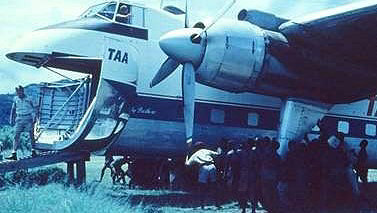
Our Engineers coped very well, with absolutely minimum equipment, with their job of keeping the Bristol’s flying. Most daily maintenance was done in the heat of the sun, without any cover for shade. A partial solution to this was to keep their spanners cool in a bucket of water while working in the open.
Pushing the aircraft up to the ramp
to unload motor vehicles.
We experienced many serviceability problems not expected by the designers. For example, the tail wheel had an electric solenoid lock that could be released for taxying and then before take-off it was locked to help keep the a/c straight on the runway. When landing and taking off on wet grass strips in the Highlands, the mud would cover the solenoid. During the flight back to Madang the mud would solidify and after landing, on some occasions, the electric solenoid was not strong enough to withdraw the lock and enable us to swing the tail to taxi. This fault required the aircraft to remain on the runway while the First Officer exited by the top hatch, walked down the fuselage and jumped off at the tail, He then lay on the ground with the aircraft fire axe and hammered the locking pin to loosen the mud. This problem was probably unknown to the Bristol designers.
Another incident may illustrate how the lack of freight handling equipment affected the job. On one flight two large steel underground fuel tanks were carried to a grass strip at Minj which served a tiny coffee growers’ district. The cylindrical tanks were loaded in Madang using fork lifts but we had no such equipment at Minj. After some discussion, the agent made contact with the local Patrol Officer. One of this Officer’s responsibilities was supervising the Bois in that district who were committed to jail for minor offences. He appeared at the airstrip with 27 of these men from the gaol. Having rope available in the cargo bay, we formed a bridle around the back of the tank, attached 2 long ropes to this, and with 13 Bois pulling on each rope they extracted the tank from the hull pulling, in unison, to a loud sing-sing cadence. These rhythmic chants were similar to the method used by the wind jammer sailors when hoisting sails, singing and pulling.
The first tank fell to the ground and was rolled away. The second now further down the sloping fuselage, was more difficult. One rope broke, spilling our willing assistants in a heap, but, with much laughter and a reef knot repaired rope, they extracted the second tank. Because of the longer ropes, when falling to the ground, this tank lacked directional control and rolled sideways. The tank fell against one open front door.
Before departure, when closing the doors, we found, with the distortion of the door, the locking dogs to secure the door could not be moved over centre into safety. Obviously we could not fly in this condition, so after more discussion, the solution was to place half the number of Bois on the outside of each door to force them tightly together so the locks could be moved into safety. We then returned to Madang where our Engineers, after our explanation, took great care unlocking the dogs before readjusting the geometry of the swing doors.
Completion of the road to Mt.Hagen did reduce the quantity of air freight required to be carried from Madang into Goroka, Mt Hagen, Minj, Banz, Baiyer River and the other major towns. We seem to have created a rod for our own backs by lifting all that heavy gear into the highlands. The transport system could now run without the assistance of the Bristol Freighters.
To conclude, in 1967, after 5 years of intensive work in NG. TAA decided to remove the Bristol aircraft from New Guinea and sell them in Australia, to Air Express. Of our two Madang based aircraft, VH-TBB continued flying with Air Express and VH-TBA was stripped for spares in Brisbane.
Super glue is something we just take for granted, you can get a pack of 6 or so tubes from Bunnings for about $2.00 and it works wonders, sticks most things together almost instantly, but what is it and how is it made. See the video below.

How to unload a Boeing – by hand.
Maurie Baston
Maurie Baston spent 18 years in the Air Force as a pilot. After the RAAF he flew Convair 880’s with Cathay Pacific Airways in Hong Kong before returning to Australia, eventually setting up his own company: Air Transport Management. He still flies his own Piper Twin Comanche, and operates an aviation consultancy business based in Australia and the USA.
As pilots, we are mostly focused on our own flying skills but, as time passes, many of us come to realise, while we do have the important flying skills, there are other skills we lack that have been solved by automation. But automation cannot always solve some of the out-of-the-ordinary events that can occasionally happen, especially when external assistance is not available.
There is the old pilot saying that states, “Make sure we don’t have to show our ace-like abilities, just give us an aircraft that doesn’t break.” Such is the value of engineers and support people who make our aircraft serviceable for us to safely go on our way. But, and it is a big “but,” the technology we now enjoy has done wonders but is it good enough to solve some situations that can result in an accident or incident that can occur requiring other skills we wish we had?
Not always!
A side effect of technology and automation is the demise of the Flight Engineer. The first exits from the flight decks were the Boeing B767 and B747-400 and other Airbus aircraft. While there are excellent arguments supporting such developments, there were always advantages in having a flight engineer aboard to assist us pilots in “managing” a flight, not just doing the flying.
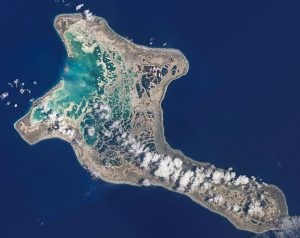
Flying from Nauru to Honolulu meant flying past a number of famous islands, like Christmas Island. Such was the situation I experienced when operating a B-727 from Tarawa to Honolulu in the 1980s. The trip over was routine, passing Howland Island where Amelia Earhart has been thought to have landed and then we flew onto Christmas Island. In those days, operations were somewhat primitive: a battery-operated NDB at destination, neither was there Air Traffic Control or a local Air-Ground operator but navigation was good with the on-board INS and Omega backup. For me, the Pacific was the greatest geography lesson I could ever had wished for. Places like Nuie, Kosrai, Funafuti, Atataki, Wallis Island and, to my surprise, towns named Paris and London on Christmas Island.
Much history has been made on the Christmas Island route during World War II. The departure airport at Kiribati was Tarawa/Batio where many thousands of casualties occurred on both the American and Japanese sides in the fighting. In the four short days, 20–23 November 1943, nearly 10,000 were either killed or wounded and of course we will always recall the infamous Japanese raids on Honolulu on 7th December 1941. The flight to Honolulu was routine; six hours at long-range cruise along the equator from Kiribati; abeam Howland island and on to Christmas Island (Pacific) then to Honolulu for an overnight return.
On this particular flight, apart from passengers returning to Kiribati, there was the normal freight of baggage and building materials, but a new addition this time was a small truck. The combi B727 was a flexible aircraft: quickly converted to an all freighter configuration, a VIP one, or in this case the forward area was configured for freight, with an all-economy section in the rear. All loading was complete and after I had ascertained there was the required unloading equipment at Christmas Island, I signed the Weight and Balance Load and Trim sheet and we departed. The first return sector was normal, we duly arrived on time at Christmas Island and all was routine until the ground personnel told us they were unable to unload the truck. That would mean we would need to take it on to another destination where unloading facilities would be available. The situation was the fork lift machine was not heavy enough to support the load and was toppling when attempting to lift the truck clear of the aircraft’s floor. What’s more, there was danger the forklift would topple into the side of the aircraft and that would have meant some serious explanations.
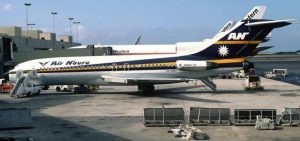
This was a situation I had experienced before during a flight from Auckland to Honiara. The whole cabin was converted to freight, no seats, and a massive carpet was loaded for the Honiara Mendana Hotel. As at Christmas Island, it could not be unloaded so we carried it to Nauru where it was unloaded and sent back to Honiara by ship, a costly exercise for someone. Meanwhile our Flight Engineer, Jack Reilly, had several suggestions. Jack was an ex-RAAF Flight Engineer and very experienced in ways that few of us pilots knew about. Jack knew the consequences of not unloading the truck and I watched him as he called some of the locals to an on-field conference.
“I want you to get me three things,” he said. “Firstly, I want the biggest, thickest ship’s hawser (rope) you can find and I want it at least 30 feet long. And with the hawser I want six of the heaviest Christmas Islanders you can find…And… I also need a team of tug-of-war players, as many as you can get to volunteer.” I had no idea what he had planned and when I asked, he said, “Not a problem. She’ll be right, Just need some muscles.”
Soon the aircraft was surrounded with many locals and amongst them were the biggest, heaviest islanders I have ever seen. Also delivered in a very large semi-trailer was the required hawser, several of them. Meanwhile Jack had gone to work under the aircraft and proceeded to disconnect the nosewheel steering unit. The unit was always disconnected when the aircraft was to be towed and could fully caster. After a tug operation, a pin was simply re-inserted and steering was then normal.
Next Jack marshalled the tug-of-war team on the opposite side of the cargo opening; then positioned the hawser around the nosewheel and on the count of “three,” commanded a practice pull… sideways! It worked. The nosewheel castored and the aircraft moved sideways about two feet. But now the real test. Carefully the fork lift was positioned as close as possible to the aircraft and gently the forks were raised to the bottom of the pallet. Jack positioned the heavy men on top of the fork lift, some sitting in each other’s laps and slowly the fork lift started to raise the truck just two inches high. Jack shouted “Pull…Pull….Pull,” and slowly the aircraft moved sideways as the truck remained suspended high and clear of the aircraft and then slowly lowered.
“There you go… Where do you want it?” he said. Such is the value of a Flight Engineer.
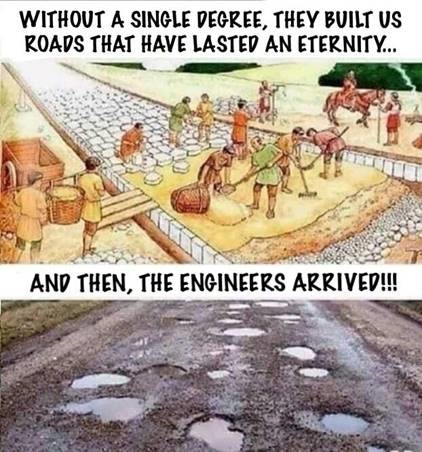
Back Go to page: 1 2 3 4 5 6 7 8 9 10 11 12 13 14 15 16 17 18 19 20 Forward